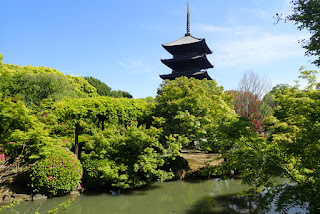Kenroku-en is a garden that is named for kenroku, which means "combined six". The design is inspired by a famous Sung-dynasty garden in China with the supposed six attributes of perfection: seclusion, spaciousness, artificiality, antiquity, abundant water, and wide vistas. The result in Kanazawa is a sprawling Edo-style landscape garden. Many of the features have been in place since the 1700's. The land was originally part of the Kanazawa Castle property and it was opened to the public in 1874.
The Kotojitoro Lantern is named for the legs of koto bridges.
The garden is known for its Karasakinomatsu pine tree
that was grown from a seed by the 13th lord of the Kaga clan.
After we had finished viewing the garden we spent an hour resting at the hotel before checking out and going back to the train station. Kanazawa has definitely been an unexpected highlight of this trip.
Our hostel in Kyoto (and home for the next five nights) is conveniently near Kyoto Station so this time we did not have to walk far with our luggage. Once we'd stored the suitcases with the hostel staff Hans suggested a walk to Toji, the Buddhist temple with a five-story pagoda. The temple itself is free but with paid admission you can enter the pretty garden and two of the historic buildings near the pagoda. You can also walk up the base of the pagoda and look inside. We were blown away by the beautiful and detailed frescoes on the inside of the pagoda.
The pagoda at Toji is the highest one in Japan, measuring 187 feet. The first one was built in the 9th century however the one today dates back to 1644. It has burned down four times due to lightning so it is no surprise that there are many long grounding cables now.
Because the area is a UNESCO World Heritage Site the government has decreed that no excavation of any kind can take place. Therefore a pile of dirt was acquired for the planting of this cherry tree.
The Kodo (lecture hall). The original was built in 835 AD and this "new" one is from the year 1491. Inside, Buddhist statues are arranged as a three-dimensional mandala. Many of the statues were missing because they are temporarily part of an exhibit at Tokyo National Museum.
Kondo (main hall). A fine example of Japanese irimoya style with the double roof.
After check in at the hostel our only mission was for food and we chose an okonomiyai restaurant. The name of the dish means "what you like" and it's one of my new favorite Japanese foods. Also, I'm fairly confident I can make it at home. It's basically an egg and flour pancake with cabbage and then whatever else you want in it: Pork, cheese, seafood. Then it's topped with some kind of dark BBQ sauce and drizzled with mayonnaise. Oh, it's so delicious! The restaurant that we went to had a twelve-seat counter and a room upstairs. We sat at the counter where the cook prepared everything on a very hot griddle and then served it to you on a secondary hot plate. Later a couple of men came in and sat in some reserved seats. They seemed very chatty with the cook and at one point one of the guys pulled out some kind of bottle of alcohol, said "Santa Claus", and then poured a glass for the cook.
Once we were settled in our hostel room for the night we very quickly fell asleep. Well, Hans did. I stayed awake with a head lamp and typed out some notes for the blog first.

















1 comment:
Sounds like good respite from the bigger cities with temple and garden walks!
Post a Comment